Eight years ago I received an email from a Western astrologer predicting a collective awakening due to the cosmic birth of the Age of Aquarius which was set to begin on February 14th, 2009. Well, it clearly did not happen, and was not based on anything that I know to be true in astrology. This idea still comes around now and then, and is quite timely now as the Moon’s South Node Ketu, which rules past karma as well as enlightenment, is transiting across the natal Moon (public, collective mind) in the sign of Aquarius in the US birth chart. In case anyone was under the impression that the Age of Aquarius is happening now or will be happening anytime soon, it is not, and I will try to explain why in this article.
 The Age of Aquarius landed in popular culture during the peace-and-love hippie era of the 60s and 70s. In 1967, the smash-hit musical Hair immortalized this notion in its opening song by the musical group The 5th Dimension. The lyrics included the following astrological fantasy: ♪♫•*¨*•.¸¸♥ ¸¸.•*¨*•♫♪♪♫•*¨*•.¸¸♥ ¸¸.•*¨*•♫♪ *When the moon is in the Seventh House…And Jupiter aligns with Mars…Then peace will guide the planets…And love will steer the stars…This is the dawning of the Age of Aquarius* ♪♫•*¨*•.¸¸♥ ¸¸.•*¨*•♫♪ ♪♫•*¨*•.¸¸♥ ¸¸.•*¨*•♫♪
The Age of Aquarius landed in popular culture during the peace-and-love hippie era of the 60s and 70s. In 1967, the smash-hit musical Hair immortalized this notion in its opening song by the musical group The 5th Dimension. The lyrics included the following astrological fantasy: ♪♫•*¨*•.¸¸♥ ¸¸.•*¨*•♫♪♪♫•*¨*•.¸¸♥ ¸¸.•*¨*•♫♪ *When the moon is in the Seventh House…And Jupiter aligns with Mars…Then peace will guide the planets…And love will steer the stars…This is the dawning of the Age of Aquarius* ♪♫•*¨*•.¸¸♥ ¸¸.•*¨*•♫♪ ♪♫•*¨*•.¸¸♥ ¸¸.•*¨*•♫♪
I don’t mean to be a killjoy, and like anyone, would welcome the Aquarian Age of “harmony and understanding, sympathy and trust abounding, no more falsehoods or derisions, golden living dreams of visions, mystic crystal revelation, and the mind’s true liberation,” but this was all just a bit premature according to astrology. Astrologers who use the actual observable sidereal zodiac agree that we will not reach the Age of Aquarius for at least a few more hundred years.
According to the late Western sidereal astrologer Garth Allen (also known as Donald Bradley): “This is definitely not the dawning of the Age of Aquarius, no matter what the song proclaims or opportunistic astrologers may say. Scientifically and historically speaking, the Aquarian Age will commence in the year 2376 A.D [using Fagan-Bradley ayanamsha].” In my calculations with this ayanamsha, the Sun on March 20, 2376 at the equinox is at 00:00 Pisces which could indicate the beginning of the Age of Aquarius. At vernal equinox of 2377, the Sun is at 29:59 Aquarius, so we are in range from 2376-2377.
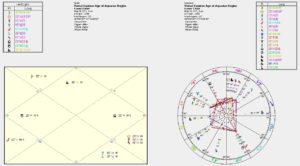 Why all this confusion? Well, the answer lies somewhat in the fact that we have two zodiacs! The zodiac used by most Vedic and some Western astrologers in the Babylonian tradition is the sidereal zodiac, which is aligned with the actual constellations of the zodiac. On the other hand, most Western astrologers use the tropical zodiac, which is aligned with the seasons via the equinoxes. The tropical zodiac begins at the vernal equinox, which occurs every year when the ecliptic (apparent path of the Sun) intersects the celestial equator around March 20-21. Tropical astrologers mark this point of intersection at 0 degrees Aries, but today, it actually has nothing to do with the constellation of Aries. For instance, on the vernal equinox of March 20, 2017, the Sun was at about 6 degrees of sidereal Pisces (Lahiri ayanamsha), i.e., the Sun was receiving cosmic radiations from the constellation of Pisces, not Aries.
Why all this confusion? Well, the answer lies somewhat in the fact that we have two zodiacs! The zodiac used by most Vedic and some Western astrologers in the Babylonian tradition is the sidereal zodiac, which is aligned with the actual constellations of the zodiac. On the other hand, most Western astrologers use the tropical zodiac, which is aligned with the seasons via the equinoxes. The tropical zodiac begins at the vernal equinox, which occurs every year when the ecliptic (apparent path of the Sun) intersects the celestial equator around March 20-21. Tropical astrologers mark this point of intersection at 0 degrees Aries, but today, it actually has nothing to do with the constellation of Aries. For instance, on the vernal equinox of March 20, 2017, the Sun was at about 6 degrees of sidereal Pisces (Lahiri ayanamsha), i.e., the Sun was receiving cosmic radiations from the constellation of Pisces, not Aries.
 The vernal equinox coincided with the constellation of Aries at around 285 CE, and so both zodiacs were aligned at that time. However, through precession of the equinoxes, the vernal point has since been moving backward (westward) against the framework of the stars. Precession of the equinoxes is due in part to the gravitational attraction of the moon and sun on the equatorial bulge of the earth, which causes the earth to wobble and its axis to describe a cone similar to a spinning top. As a result, the celestial equator (the plane extending from the Earth’s equator) moves on the celestial sphere, whereas the ecliptic (the apparent path of the Sun) is not affected by this motion.
The vernal equinox coincided with the constellation of Aries at around 285 CE, and so both zodiacs were aligned at that time. However, through precession of the equinoxes, the vernal point has since been moving backward (westward) against the framework of the stars. Precession of the equinoxes is due in part to the gravitational attraction of the moon and sun on the equatorial bulge of the earth, which causes the earth to wobble and its axis to describe a cone similar to a spinning top. As a result, the celestial equator (the plane extending from the Earth’s equator) moves on the celestial sphere, whereas the ecliptic (the apparent path of the Sun) is not affected by this motion.
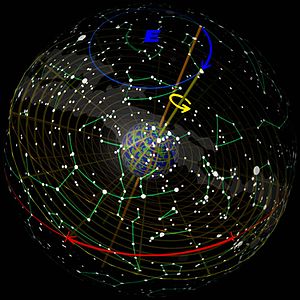 Above Image: Precessional movement as seen from ‘outside’ the celestial sphere (Wikipedia)
Above Image: Precessional movement as seen from ‘outside’ the celestial sphere (Wikipedia)
The equinoxes, which lie at the intersections of the celestial equator and the ecliptic, move on the celestial sphere. Similarly, the celestial poles rotate on the celestial sphere, so that there is a continual change in the star at or near one of the poles. After a period of about 25,800 years (a Platonic Year), the equinoxes and poles lie once again at nearly the same points on the celestial sphere. Also once during each Platonic Year, the starting points of the sidereal and tropical zodiacs coincide. After this, the points will separate from each other by one degree of arc every 71.5 years.
The astrological ages are linked with precession of the equinoxes. There are at least two different ways to divide the Great (Platonic) Year into twelve astrological ages. The simple method is to divine the Great Year into twelve astrological ages of equal lengths of around 2,150 years each, reflecting the movement of the vernal point through the sidereal zodiac. Thus, the spring equinox moves from one constellation to the previous one approximately every 2,150 years (give or take a few years).
Currently the Sun at vernal equinox is in the constellation of Pisces, so we are in the Age of Pisces, but in a few more hundred years or so, vernal equinox will be observed in the constellation of Aquarius, and we will then be in the Age of Aquarius. “According to the Belgian astronomer and mathematical wizard Jean Meeus, who adheres to the IAU’s (International Astronomical Union’s) definitions, the Sun at the March equinox passed from being in front of the constellation Aries and to being in front of the constellation Pisces in 68 B.C. Looking ahead, again according to Jean Meeus, the March equinox will cross over into the constellation Aquarius in 2597…these are the astronomical dates, based on IAU constellation boundaries established in 1930.” (“When will the age of Aquarius begin?” by Bruce McClure and Deborah Byrd in Human World | February 22, 2017)
Astrologers do not agree about the starting date of the Age of Aquarius, and this is in part due to the fact that the constellations of astrology do not have actual lines of demarcation. Additionally, sidereal astrologers cannot agree over the precessional rate variable or the starting date or the “date of coincidence” when the two zodiacs line up, so we don’t have just one ayanamsa, which is the mathematical/longitudinal difference we have to use to calculate the sidereal zodiac from the tropical.
However, most sidereal astrologers agree that the Age of Aquarius will commence sometime between 2117 and 2600 A.D. If we use Lahiri ayanamsha and calculate for the vernal equinox in the same way that Bradley did, then the equinox (vernal point) changed from Aries to Pisces in the years 285/286 CE (at the vernal equinox of 285, it was 00:00 Aries, and in 286 it was 29:59 Pisces). Going forward to the equinox of 2438-2439, the same thing happens, as the vernal point slips from 00:00 Pisces to 29:59 Aquarius. So the answer for when the Age of Aquarius begins using Lahiri ayanamsha is from 2438-2439.
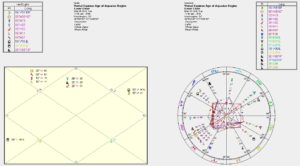
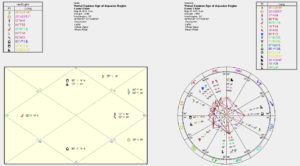 Though we are not technically in the Age of Aquarius yet, the fact that there are no separating edges between the constellations indicates that we are in the process of moving toward Aquarius, as the vernal equinox Sun is now within a six-degree orb of Aquarius. Thus, we are slowly beginning to receive the influx of Aquarian energies that relate to democracy, scientific breakthroughs, technological innovation, and the awakening of consciousness. Aquarius is the sign of the Water Bearer who carries the kundalini shakti (spiritual essence of truth), which we hope can awaken humanity from its “ancient slumber.” Aquarius is forward thinking and inventive, known to be interested in science, healing, occult wisdom, higher knowledge, and humanitarianism.
Though we are not technically in the Age of Aquarius yet, the fact that there are no separating edges between the constellations indicates that we are in the process of moving toward Aquarius, as the vernal equinox Sun is now within a six-degree orb of Aquarius. Thus, we are slowly beginning to receive the influx of Aquarian energies that relate to democracy, scientific breakthroughs, technological innovation, and the awakening of consciousness. Aquarius is the sign of the Water Bearer who carries the kundalini shakti (spiritual essence of truth), which we hope can awaken humanity from its “ancient slumber.” Aquarius is forward thinking and inventive, known to be interested in science, healing, occult wisdom, higher knowledge, and humanitarianism.
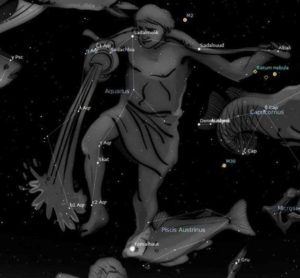 We may want to be in the Age of Aquarius now because we presume this era will bring humanity into a Golden Age of peace and oneness. However, according to my calculations based on the teachings of Swami Sri Yukteswar’s alternate 24,000-year yuga system, the Golden Age of Truth and Enlightenment in which all beings will live in total harmony, known as Sat/Satya Yuga, is still over 5000 years away; it’s estimated to occur from 7699 to 12,4999 AD. Sat Yuga will occur during the Age of Sagittarius after the completion of the Age of Aquarius and Age of Capricorn. For now, we are still in the Age of Pisces, an epoch that has seen the gradual growth of compassion and humanitarianism linked with both positive and negative religious influences.
We may want to be in the Age of Aquarius now because we presume this era will bring humanity into a Golden Age of peace and oneness. However, according to my calculations based on the teachings of Swami Sri Yukteswar’s alternate 24,000-year yuga system, the Golden Age of Truth and Enlightenment in which all beings will live in total harmony, known as Sat/Satya Yuga, is still over 5000 years away; it’s estimated to occur from 7699 to 12,4999 AD. Sat Yuga will occur during the Age of Sagittarius after the completion of the Age of Aquarius and Age of Capricorn. For now, we are still in the Age of Pisces, an epoch that has seen the gradual growth of compassion and humanitarianism linked with both positive and negative religious influences.
Though humanity moves within a variety of these massive overlapping time cycles, we do not as individuals have to be bound by them. The greatest spiritual masters have taught that each of us has the power to individually break free from the mass mind to evolve into higher consciousness now. Paramahansa Yogananda said that to do this, we have to transfer our allegiance from the creation to the creator. So we mustn’t really be too concerned about when the Age of Aquarius or Sat Yuga will arrive. They can happen now for those beings on the conscious spiritual path who are seeking to transcend the chains of time.
Let the sunshine, let the sunshine in, the sunshine in
Let the sunshine, let the sunshine in, the sunshine in
Let the sunshine, let the sunshine in, the sunshine in
Oh, let it shine, c’mon
Now everybody just sing along
Let the sun shine in
Open up your heart and let it shine on in
When you are lonely, let it shine on
Got to open up your heart and let it shine on in
And when you feel like you’ve been mistreated
And your friends turn away
Just open your heart, and shine it on in
(*lyrics from Aquarius: Let the Sunshine In by The Fifth Dimension)
 Thanks to Vedic astrologer Steve Stuckey for his assistance and advice on this article.
Thanks to Vedic astrologer Steve Stuckey for his assistance and advice on this article.
